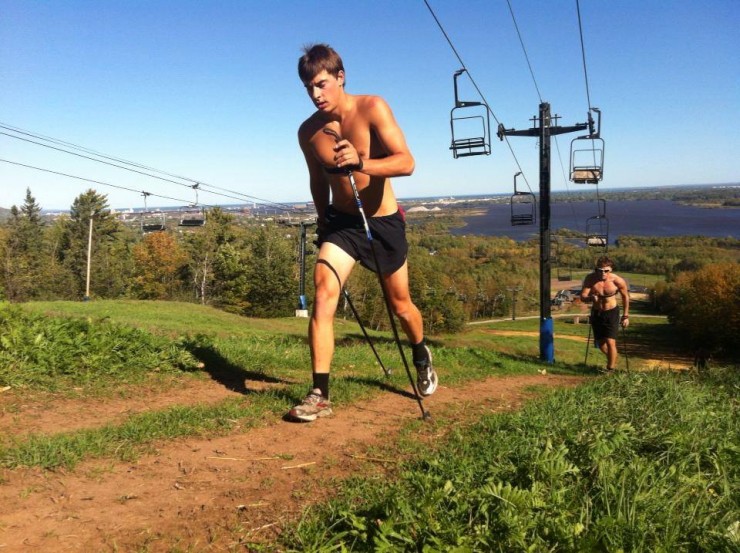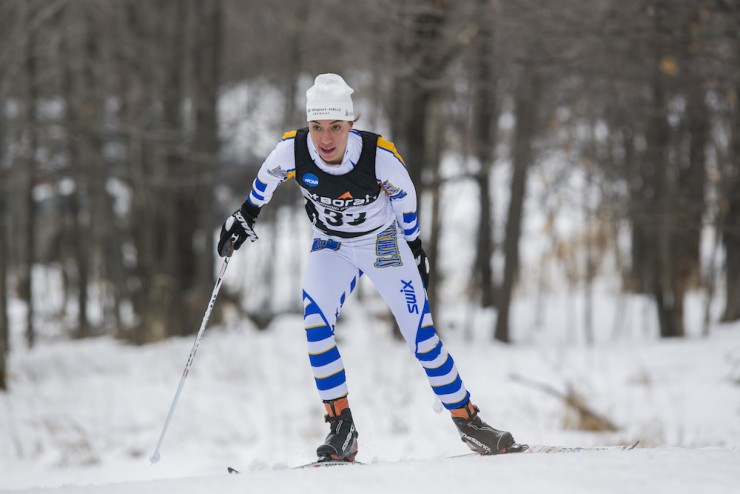
This week’s workout comes to us from Chad Salmela, head coach of The College of St. Scholastica in Duluth, Minn. Last month, Central Collegiate Ski Association (CCSA) coaches voted Salmela Women’s Coach of the Year. While the collegiate season is on hiatus, this “Death Blow” maximal-anaerobic-output-capacity workout remains one of Salmela’s favorites.
***
The concept is an old Finnish “peaking” workout I used to do as an athlete to bring on my best performances. I believe my old coach, John Underwood, fed me the parameters of this workout when I was a junior athlete. I did this kind of workout a lot at home over Christmas before going to world team/Olympic trials events when we used to pick international teams that way.
What I love about this workout is the raw intensity and guts required while doing it. It is very challenging done right, and the psychological challenge is superb for competitive toughness while having clear physical adaptation goals. Most of all, it’s low tech with great built-in monitoring requiring no gadgets, so technology isn’t necessary for effective feedback as a coach.
As I came to understand the workout and cause-and-effect of training, I have used and continue to use this workout, adjusting it within approaches to individual athletes in my current coaching practice. Really what it does is it spurs on anaerobic power when the adaptation clearly isn’t developed to the point it needs to be for top performance. It probably isn’t applicable as much to modern elite ski racers’ models of training, but it might be in some cases.
Background:

The name stems from when I coached the Marshall School High School cross-country running team in Duluth in the early 2000s, coupled with my love and frequent watching of Seinfeld at the time. In one episode, Jerry and Kramer were getting fired up to go see a movie called Death Blow. Speaking in movie trailer schtick, Kramer says, “Death Blow! Not because of who you are, but for different reasons entirely!” or something absurd like that.
I wanted this workout to be our Excalibur—our weapon. I wanted this workout to have a life and culture of its own, and eventually with my running teams, it did. It became and remains the Death Blow — in how it felt, and how it effectively crept up on our competitors at the end of the season.
Marshall was not a running powerhouse, but the kids were awesome and fun. They would come in to the first practice late summer in all sorts of physical disarray save one or two fired up kids. These were not “athletes” by and large, though what kid in a singlet and shorts with their school’s name on them isn’t an “athlete” at that age?
I spent the first half of the 12 weeks I had with them, building aerobic efficiency, using every ounce of their limited physical energy just to be able to move some oxygen through their bodies at an effort that wasn’t herculean so that later, the herculean effort were wicked fast by comparison to Week 1 ability. With this approach, we would really get slaughtered in the first few races of the year, but the Death Blow took care of all that later.
Racing and an increase in controlled Level 3 (L3) intervals on a standard loop, would slowly bring the athletes to better running performances as the season progressed. But when we’d get close to the section meet to try to qualify for the state championship, we went to a cycle of death blows, and the kids would improve in two weeks so profoundly I almost never had so much fun as a coach. Almost.
If we qualified for state, it was a shocker to everyone in our section and almost to me. Almost. But with this approach, we were definitely as ready for a state meet as we’d be with any other should we surprise and qualify. The momentum worked perfectly.
Today, I use it with my skiers, who have a much more thorough training trajectories, aerobic development, and have much more comprehensive systems of bringing on their anaerobic power, primarily for athletes who have raced a bunch but still haven’t seemed to reach into their anaerobic bag of tricks fully.

In early February of this year, I stood out on the slopes of Spirit Mountain alpine area at the crack of dawn in 0 degrees Fahrenheit before the hill opened, urging on one of my skiers to go further and dig deeper, and reeeeeach! Four reps was all she needed. That athlete raced pretty awesome after that morning and felt the bump of the Death Blow.
The Workout:
- Get warmed up well, however long that takes, but be ready to throw down for real when you start the reps. Throw some L3 pickups into the warmup to open up your heart’s ability to do maximal work.
- On undulating terrain, ski like you’re in a race. Use the time to ski perfectly, but ski like you’re nearing go time at the end of a 10-kilometer race. Do this for 2 minutes.
- At the end of 2 minutes and continuing the rep, be at the bottom of a very tough, long uphill and have a clear mark in the snow at the bottom of that hill where 2 minutes is.
- At the mark, either have a watch set for 1 minute to count down or have a coach time you for one minute. Run, bound, or ski as absolutely all out and as far up the hill as you possibly can.
- At the end of a minute, mark your progress in the dirt, grass or snow, after you’ve arisen from the heap on the ground you became. That mark now becomes the goal.
- Recover fully for the next repetition.
- Do the exact same process after full recovery.
- Mark the distance up the hill again. If you drop more than 30 meters from the original mark, the workout is over. If you are within that distance, and ESPECIALLY if you exceed it, repeat.
- If you keep meeting the mark and are exhausted, stop and do the workout again in the future when you are physically ready to do it again.
- In all my years and all the athletes I’ve coached, I’ve only seen one athlete do as many as eight reps with this workout and we called it after that eighth rep. This athlete was categorically put together by a lot of slow-twitch muscle fiber and only did half that the next time, showing progress.
The Analysis:
- It is important not to get hung up on how many reps of this nature you can do. The goal is to ensure you have peak anaerobic output.
- If you can continue to come close to the first mark even if you lose a little distance, you are not yet at your maximal anaerobic output capacity.
- If your second interval is already at 30 meters back or further, STOP! And never do this workout again in that season.
- More reps = less anaerobically developed at the time of the workout. Fewer reps = well anaerobically developed, and you don’t need to continue the stress. End the workout.
- Without gadgetry, this workout gives me a clear picture of where we are in the spectrum of an athlete being anaerobically fit.
When to do it:
- When you know your athlete(s) need some sort of strong anaerobic power boost (high schoolers who need to giddy up and go) and you’ve done about as much aerobic training as you can with the season you have left.
- An athlete who takes longer than most to “come around” with racing, and you’re running out of time to “the big one.”
- Advanced and elite athletes who have been racing well for a while but don’t feel like they can really “go to the well” yet.
- Advanced and elite athletes coming off a re-build of base during the long race season and need very quickly to get into top race output mode again. Might only take 2 reps to be a great stimulus.
Warning:
While it sounds awesome and hard core, the Death Blow can backfire, particularly when an athlete is past peak fitness but believes they haven’t hit an anaerobic output peak yet. This workout can bury an athlete’s season in such a case. I speak from experience on this issue.
So be honest with yourself or your athlete if you are a coach trying this. Always stop after the second rep if you fall way off the mark! It’s a sign you can already do what the workout is trying to develop.



